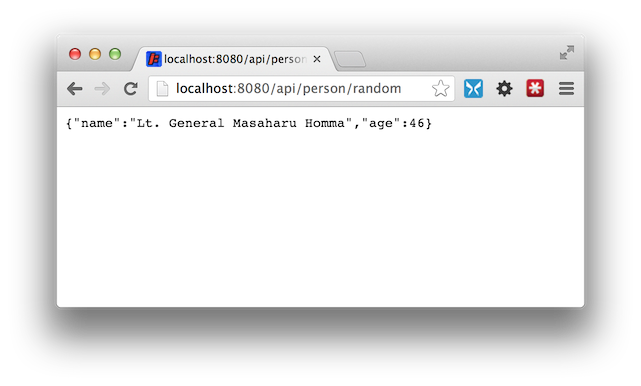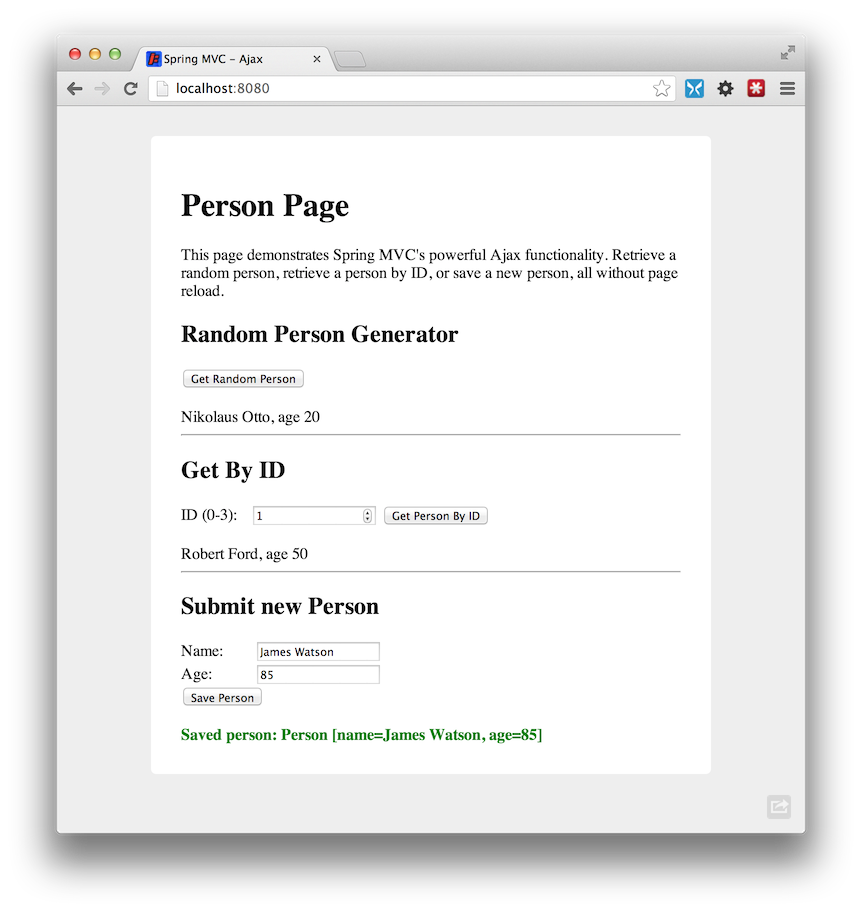Spring MVC – Easy REST-Based JSON Services with @ResponseBody
Spring 3 makes JSON REST services really easy. This tutorial will show you how in just a few steps. You can grab the code on GitHub.
Prerequisites
You should have a working Spring MVC Application. If you do not already have a working Spring MVC application set up, follow this tutorial. We will define three REST services: 1) to retrieve a random Person, 2) to retrieve a Person by ID, and 3) to save a new Person. The services will be consumed using jQuery on a sample page we will set up. First, I will show the Spring Controller for our REST services, and then we will walk through how they work:
PersonController.java
package com.codetutr.controller;
import org.springframework.beans.factory.annotation.Autowired;
import org.springframework.stereotype.Controller;
import org.springframework.web.bind.annotation.PathVariable;
import org.springframework.web.bind.annotation.RequestMapping;
import org.springframework.web.bind.annotation.RequestMethod;
import org.springframework.web.bind.annotation.RequestParam;
import org.springframework.web.bind.annotation.ResponseBody;
import com.codetutr.domain.Person;
import com.codetutr.service.PersonService;
@Controller
@RequestMapping("api")
public class PersonController {
PersonService personService;
@Autowired
public PersonController(PersonService personService) {
this.personService = personService;
}
@RequestMapping("person/random")
@ResponseBody
public Person randomPerson() {
return personService.getRandom();
}
@RequestMapping("person/{id}")
@ResponseBody
public Person getById(@PathVariable Long id) {
return personService.getById(id);
}
/* same as above method, but is mapped to
* /api/person?id= rather than /api/person/{id}
*/
@RequestMapping(value="person", params="id")
@ResponseBody
public Person getByIdFromParam(@RequestParam Long id) {
return personService.getById(id);
}
/**
* Saves new person. Spring automatically binds the name
* and age parameters in the request to the person argument
* @param person
* @return String indicating success or failure of save
*/
@RequestMapping(value="person", method=RequestMethod.POST)
@ResponseBody
public String savePerson(Person person) {
personService.save(person);
return "Saved person: " + person.toString();
}
}OK, so, as you can see, we have 4 request handlers in this controller. The first method returns a random person. The next two retrieve a person by ID – just two different approaches to the URL mapping. The last method saves a person.
Remember how Spring controllers usually return a type String (to indicate the resulting view name). Instead, here we are using Spring’s @ResponseBody annotation and returning the object that we want to send to the client. The @ResponseBody annotation tells Spring that we will be returning data in the response body rather than rendering a JSP.
When the @ResponseBody annotation is used, Spring will return the data in a format that is acceptable to the client. That is, if the client request has a header to accept json and Jackson-Mapper is present in the classpath, then Spring will try to serialize the return value to JSON. If the request header indicates XML as acceptable (accept=application/xml) and Jaxb is in the classpath and the return type is annotated with Jaxb annotation, Spring will try to marshall the return value to XML.
As I mentioned, if you want your services to return JSON, you have to have Jackson in the classpath. Here is the only dependency you need to add to your project:
Gradle
compile 'org.codehaus.jackson:jackson-mapper-asl:1.9.12'
Or, if you’re using Maven:
<dependency>
<groupId>org.codehaus.jackson</groupId>
<artifactId>jackson-mapper-asl</artifactId>
<version>1.9.12</version>
</dependency>Alternatively, if you want your services to return XML, include your favorite Jaxb implementation, eg. com.sun.xml.bind:jaxb:2.1.9.
In a minute, we’ll build a front end to call these services using AJAX, but if you deploy your application now, you can try out your services using a REST client (or just typing the URL into your browser). Eg:
You can stop following along if you’re content with that. I will just connect all the pieces now by coding the client-side jQuery:
home.jsp
<%@ taglib prefix="c" uri="http://java.sun.com/jsp/jstl/core" %>
<%@ taglib prefix="form" uri="http://www.springframework.org/tags/form" %>
<!DOCTYPE HTML>
<html>
<head>
<title>Spring MVC - Ajax</title>
<script src="//ajax.googleapis.com/ajax/libs/jquery/1.9.1/jquery.min.js"></script>
<style>
body { background-color: #eee; font: helvetica; }
#container { width: 500px; background-color: #fff; margin: 30px auto; padding: 30px; border-radius: 5px; box-shadow: 5px; }
.green { font-weight: bold; color: green; }
.message { margin-bottom: 10px; }
label { width:70px; display:inline-block;}
.hide { display: none; }
.error { color: red; font-size: 0.8em; }
</style>
</head>
<body>
<div id="container">
<h1>Person Page</h1>
<p>This page demonstrates Spring MVC's powerful Ajax functionality. Retrieve a
random person, retrieve a person by ID, or save a new person, all without page reload.
</p>
<h2>Random Person Generator</h2>
<input type="submit" id="randomPerson" value="Get Random Person" /><br/><br/>
<div id="personResponse"> </div>
<hr/>
<h2>Get By ID</h2>
<form id="idForm">
<div class="error hide" id="idError">Please enter a valid ID in range 0-3</div>
<label for="personId">ID (0-3): </label><input name="id" id="personId" value="0" type="number" />
<input type="submit" value="Get Person By ID" /> <br /><br/>
<div id="personIdResponse"> </div>
</form>
<hr/>
<h2>Submit new Person</h2>
<form id="newPersonForm">
<label for="nameInput">Name: </label>
<input type="text" name="name" id="nameInput" />
<br/>
<label for="ageInput">Age: </label>
<input type="text" name="age" id="ageInput" />
<br/>
<input type="submit" value="Save Person" /><br/><br/>
<div id="personFormResponse" class="green"> </div>
</form>
</div>
<script type="text/javascript">
$(document).ready(function() {
// Random Person AJAX Request
$('#randomPerson').click(function() {
$.getJSON('${pageContext.request.contextPath}/api/person/random', function(person) {
$('#personResponse').text(person.name + ', age ' + person.age);
});
});
// Request Person by ID AJAX
$('#idForm').submit(function(e) {
var personId = +$('#personId').val();
if(!validatePersonId(personId))
return false;
$.get('${pageContext.request.contextPath}/api/person/' + personId, function(person) {
$('#personIdResponse').text(person.name + ', age ' + person.age);
});
e.preventDefault(); // prevent actual form submit
});
// Save Person AJAX Form Submit
$('#randomPerson').click(function() {
$.getJSON('${pageContext.request.contextPath}/api/person/random', function(person) {
$('#personResponse').text(person.name + ', age ' + person.age);
});
});
$('#newPersonForm').submit(function(e) {
// will pass the form date using the jQuery serialize function
$.post('${pageContext.request.contextPath}/api/person', $(this).serialize(), function(response) {
$('#personFormResponse').text(response);
});
e.preventDefault(); // prevent actual form submit and page reload
});
});
function validatePersonId(personId) {
console.log(personId);
if(personId === undefined || personId < 0 || personId > 3) {
$('#idError').show();
return false;
}
else {
$('#idError').hide();
return true;
}
}
</script>
</body>
</html>Once you have everything in place, you should have a page that looks like this:
Full Source:
ZIP, GitHub
To run the code from this tutorial: Must have Gradle installed. Download the ZIP. Extract. Open command prompt to extracted location. Run gradle jettyRunWar. Navigate in browser to http://localhost:8080.
References








really good tutorial
thanks mate :)
Great Tutorial! Just wondering if this is being run on Tomcat 7? I cannot seem to make any AJAX GET requests when applying the principles in this tutorial. I continually get a 403 Forbidden error, all by spring security configuration has been done correctly. I can access what I like when I use REST just fine.
I dont understand why, but I finally resolved my issue. In the AJAX $.get request I specified the actual URL of the request ‘http://localhost:8080/../etc’ and it worked. Although, when I actually gave it ‘${pageContext.request.contextPath}/etc/..’ it does not work.
ajax requests must be on the same domain check XDR for more info
Good tutorial, but you dont include the servlet configuration.
Could you please include it? Thanks
@roberto ciucci giuliani
https://github.com/stevehanson/spring-mvc-ajax
;-)
Interesting, i m trying to receive an array of object like this…But i have some problem..if you could help me out that would be very helpful ;) http://stackoverflow.com/questions/24314075/spring-mvc-could-not-read-json-can-not-deserialize-instance-of-java-util-vect